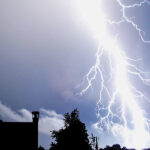With storm-related collapses of outdoor stage structures in the news this year, there have been extensive discussions on topics ranging from wind loads on truss structures to foul weather evacuation protocols. Here, we take a closer look at one of the many critical inter-related factors that all add up to truss collapse prevention and stage safety: The problem of unpredictable load distribution and the importance of load monitoring.
The Problem
The first step toward safely lifting and hanging equipment is to know the weight of each individual load, know the total weight on a structure, and know that the structure can safely handle that load. But even when individual loads are known and the total weight on a structure established, unpredictable load distribution still looms as a major potential safety hazard — for temporary structures, assembled indoors or out, and in some cases, even for the building itself.
Each time there are more than two supports on a truss or more than three supports on a structure, a “statically indeterminate” loading condition occurs. This means that loads are being distributed on a structure in a manner that is very difficult to predict. As a result, some of the building rigging points, equipment and motors may become dangerously overloaded — while other may bear only a small part of the load.
Experiments have shown that structures that seem to be visually well-balanced can actually be prone to imbalanced load distribution. Some of the hoists can be severely overloaded, posing a danger to those below. The danger escalates with the trend toward heavier gear and moving structural elements.
Although major stage collapses are still quite rare, it’s not difficult to obtain anecdotal evidence of structural risks. Just ask a rigger two questions: “How many times has a situation been potentially close to failure, and nobody knew?” And, “How many times has a little bit of good luck averted an accident?”
With the lives of performers, crew and audience members hanging in the balance, the problem of unpredictable load distribution cannot be left to good luck. The first step is to monitor the loads that are lifted and hung above performers, audience and crew. The cost of load monitoring is inconsequential compared to the cost of an accident.
The Solution
The general principles of risk management include the identification, assessment, and prioritization of risks, followed by coordinated and economical application of resources to minimize, monitor, and control the probability and/or impact of unfortunate events.
For the specific issue of load distribution, Eilon Engineering has developed the Ron StageMaster system. As Ilan Bahar, Ron StageMaster product manager notes, the system provides those managing structures with a complete load monitoring solution (wireless or wired) that includes computerized real-time monitoring and early warning of potential load-related hazards.
“The Ron StageMaster system grants the rigger a real-time load map that enables him to monitor the loads, balance them and avoid overload,” Behar says. “The system can also be integrated to the controller and stop the hoists in those cases where this would be the best immediate action.”
Along with the load map’s ability to help riggers quickly identify the relevant motor / motors and a respond with load compensation quickly to better balance the loads, the Ron StageMaster system is designed to detect and monitor unpredictable load distribution of suspended stage equipment the moment they start to develop. Each system also provides detailed measurement of the tension in components. The load cells also can be used to monitor high-risk components such as catenary or guy wires.
Summing Up
The people in charge of managing structures indoors and in the open air need to make any effort possible to reduce the risks of structural collapse. Unpredictable load distribution is not just a phenomenon in physics, it is an issue entertainment riggers need to deal with every day. Any show that involves lifting / moving / hanging loads above people should only be carried out with full knowledge of the forces involved. The Ron StageMaster can provide more information about those forces — and a quick-response way of dealing with them as they arise — in a way that visual guesswork
For more information, go to www.eilon-engineering.com.

